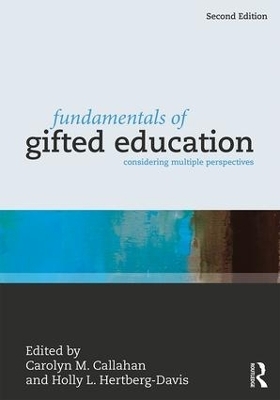
Fundamentals of Gifted Education
Routledge (Verlag)
978-1-138-19238-6 (ISBN)
Carolyn M. Callahan is Commonwealth Professor Emeritus of Education at the University of Virginia. She has been a principal investigator on projects of the National Research Center on the Gifted and Talented for more than 20 years. She has published more than 200 refereed articles and 50 book chapters across a broad range of topics on gifted education. She is a Past-President of The Association for the Gifted and the National Association for Gifted Children and co-editor of Critical Issues in Gifted Education. Holly L. Hertberg-Davis is an educational consultant specializing in differentiation of instruction, advanced curriculum, and professional development.
Chapter 1: Introduction Part I. Foundations 2. Beliefs, Philosophies, and Definitions Chapter 3. An Eventful Modern History of Gifted Education 4. Policy-Related Definitions of Giftedness: A Call for Change 5. Gifted Behaviors versus Gifted Individuals 6. The DMGT/IMTD: Building Talented Outputs Out of Gifted Inputs 7. Problematizing Gifted Education: Thinking Radically About Our Beliefs and Practice Part II: Identification 8. Considerations for the Identification of Gifted and Talented Students 9. Identification of Gifted and Talented Students 10. Traditional Identification Instruments 11. Uses and Misuses of Matrices in Identifying Gifted Students: Considerations for Better Practice 12. Identifying Gifted Learners: Utilizing Non-verbal Assessment 13. Utilizing Non-test Assessments in Identifying Gifted and Talented Learners 14. Response to Intervention (RtI) Approaches to Identification in Gifted Education 15. The Characteristics of Gifted and Talented Students Part III: Service Delivery Options and Programming Models for Gifted Students 16. Contexts for Instruction: An Introduction to Service Delivery Options and Programming Models in Gifted Education 17. Evidence Overcomes Excuses: Academic Acceleration is an Effective Intervention for High Ability Students 18. Pull-Out Programs as a Service Delivery Option 19. The Schoolwide Enrichment Model: A Focus on Student Creative Productivity, Strengths and Interests 20. Cluster Grouping 21. Programming Response to the Social and Emotional Characteristics of Gifted Children 22. Options for Secondary Gifted Students Part IV. Curricular and Instructional Decisions 23. Defensible Curriculum for Gifted Learners: Where the Rubber Meets the Road 24. The Multiple Menu Model: A Guide for Developing Gifted Differentiated Curriculum and Instruction 25. Differentiating with Depth and Complexity 26. Differentiated Instruction 27. The CLEAR Curriculum Model 28. Integrated Curriculum Model 29. The Parallel Curriculum Model 30. Advanced Placement and International Baccalaureate Programs Part V. Specific Populations 31. Heterogeneity among the Gifted: Not an Oxymoron 32. Gifted Males and Females: The Same but Different 33. Twice-exceptional Students: Gifted Students with Disabilities Impacting Learning 34. Underachieving Gifted Students 35. Gifted African Americans 36.Increasing the Participation and Success of African-American Students in Gifted Programs 37. Gifted Latino Students: Identifying and Nurturing Talent 38. Gifted Students from Rural Environments 39. Highly Gifted Students PART VI. Parents and Gifted Students 40. Working with Parents of Gifted Students 41. Parents and the Development of Gifted Students 42. Parenting a Twice Exceptional Child 43. Homeschooling: An Alternative Approach for Gifted and Talented Learners? Part VII. Evaluation and Policy in Gifted Education 44. Evaluating, Reflecting, Affirming, and Redirecting: An Introduction to the Evaluation of Gifted Programs 45. Evaluating Curriculum Models Used in Gifted and Talented Programs 46. Evaluating Services Offered to Gifted and Talented Students: A Planning Guide 47. Policy and Gifted Education
| Erscheinungsdatum | 03.02.2018 |
|---|---|
| Zusatzinfo | 35 Tables, black and white; 24 Line drawings, black and white |
| Verlagsort | London |
| Sprache | englisch |
| Maße | 178 x 254 mm |
| Gewicht | 1020 g |
| Themenwelt | Sozialwissenschaften ► Pädagogik ► Didaktik |
| Sozialwissenschaften ► Pädagogik ► Schulpädagogik / Grundschule | |
| Sozialwissenschaften ► Pädagogik ► Sonder-, Heil- und Förderpädagogik | |
| ISBN-10 | 1-138-19238-4 / 1138192384 |
| ISBN-13 | 978-1-138-19238-6 / 9781138192386 |
| Zustand | Neuware |
| Haben Sie eine Frage zum Produkt? |
aus dem Bereich


